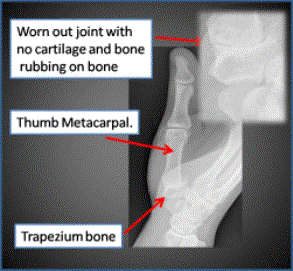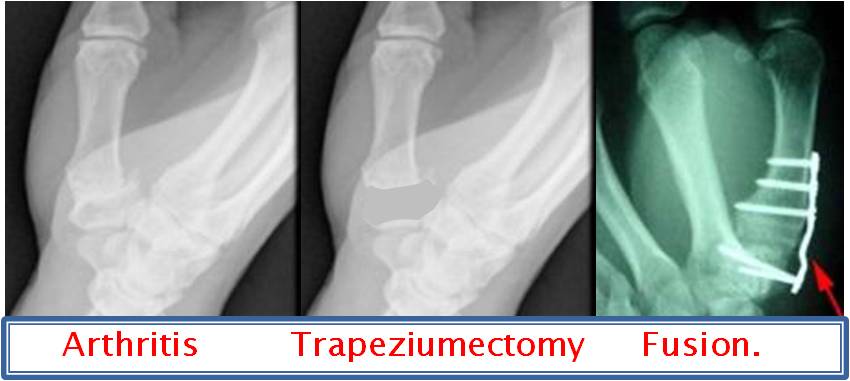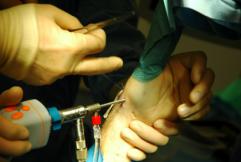Basal Thumb Arthritis
 Osteoarthritis is wear and tear in a joint. In base of thumb arthritis the joint between the thumb (metacarpal bone) and the wrist (trapezium) is affected.
Osteoarthritis is wear and tear in a joint. In base of thumb arthritis the joint between the thumb (metacarpal bone) and the wrist (trapezium) is affected.
Why do I have arthritis?
It is a common site because it is a universal joint moving in all directions and is exposed to great forces when using the hand. The commonest cause is a family history of arthritis and a genetic predisposition. Sometimes it is as a result of an injury to the cartilage or bone. It typically starts as an ache when using the hand to pinch and twist, such as turning a door handle or a jam jar lid. It then becomes more severe with the periods of pain and swelling becoming more prolonged.
What are the non-surgical treatments?
The symptoms can often be controlled with thumb splints and painkillers such as ibuprofen. If these fail to control the pain and loss of function; the next step is an injection of steroid and local anesthetic into the joint. These can be very effective in relieving pain as the hydrocortisone acts as a powerful anti inflammatory.
| Information on hydrocortisone injections. After the injection the joint should be rested for 24 hours and the sticky plaster should remain on to prevent anything from entering the puncture site. Very rarely problems can occur with steroid injections- When the local anesthetic has worn off (about 4 hours), a few patients experience some pain, this will decline over a day or two. If you are diabetic your blood sugars should be monitored for the 6 hours following the injection. Infection is very rare and is reported to occur in 1 in 15000 patients. The skin overlying the injection site can become pale and thin, this is called lipodystrophy. |
The steroid injection works to mask the symptoms of the arthritis. It tends to work for 3-12 months but in some patients it hardly helps at all. In this situation surgery should be considered.
What operation?
Surgery is indicated when all other measures have failed and the pain is affecting your activities of daily living, or you are unable to work. The type of operation you have depends on the extent of the arthritis, your age and activity levels.
Trapeziumectomy. Most people are very well served with a trapeziumectomy. This is an operation where the trapezium bone is removed from the wrist and the gap is filled with a sling of tendon taken from the forearm. Reports of over 95% long term satisfaction has made this the gold standard treatment for base of thumb arthritis. Because this operation leaves you with some weakness in power and pinch grip there are some patients who are better served with a fusion.

Fusion. If you are young or a manual worker a fusion of the trapezium to the thumb  bone is sometimes preferred. This gets rid of the pain, gives a strong pinch grip and still allows some reduced movement, in other words power at the expense of movement.
bone is sometimes preferred. This gets rid of the pain, gives a strong pinch grip and still allows some reduced movement, in other words power at the expense of movement.
Key hole surgery. The second group are those
who are aged between 45 and 65 and have mild arthritis, these patients can have an arthroscopic interposition arthroplasty. This is a key hole operation where the painful cartilage is shaved away and a tendon is made into a cushion and held in the gap to make a false joint. This gives better grip strength and allows movement.
What should I expect after my operation?
While in the initial bandage or cast, you will have limited use of your hand. When you are seen at the clinic approximately two weeks after the operation, your wound will be cleaned and any visible stitches removed. There may be bruising and swelling. At that point a splint or further cast will be made or applied by the hand therapist. It should be worn for a further two weeks. The hand therapist will give you advice regarding exercises to aid recovery. It is quite normal to lose strength in the thumb and it can take up to a full year to gain maximum improvement.
What are the risks?
You will be asked to sign a consent form to demonstrate that you understand what operation is being done and why. Complications of routine hand operations are very rare
Infection - risk is low and will respond well to antibiotics.
Pain - The thumb may remain uncomfortable for up to six months, while the scar within the joint consolidates and settles.
Stiffness - approximately 5% of patients may have problems with increased stiffness in their hand.
Nerve injury - Localized numbness around the wound and over the thumb may occur, which usually resolves with time.
Shortening - If you have the trapeziumectomy, as the bone has been removed, the thumb may shorten which may reduce your the span of your hand.
 When can I return to driving and work?
When can I return to driving and work?
Because the thumb is wrapped around the steering wheel when driving it is at risk if you need to brake sharply or crash. It also difficult to control the car while in a splint, so driving is not safe until 6 weeks post surgery.



